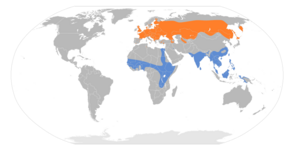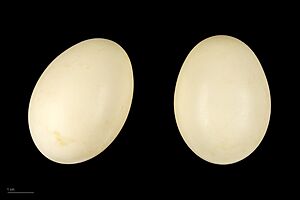Garganey facts for kids
Quick facts for kids Garganey |
|
|---|---|
 |
|
| Male | |
| Conservation status | |
| Scientific classification | |
| Genus: |
Spatula
|
| Species: |
querquedula
|
 |
|
| Synonyms | |
|
|
The garganey (Spatula querquedula) is a small type of duck that feeds by dabbling. These ducks live and breed across much of Europe and Asia. But they don't stay there all year! Garganeys are migratory, meaning they fly long distances. Every winter, the entire population travels to warmer places like Africa, India, Bangladesh, and Australia. You can often see huge groups of them there.
Garganeys were first officially described in 1758 by a famous scientist named Carl Linnaeus. Like other small ducks, they can take off from the water very quickly. They fly with fast, twisting movements. When it's time to breed, garganeys like to live in grasslands next to shallow marshes or lakes.
Contents
What's in a Name? (Taxonomy)
The first official description of the garganey was made by a Swedish scientist, Carl Linnaeus, in 1758. He gave it the scientific name Anas querquedula. Scientists use these two-part names to make sure everyone knows exactly which animal they are talking about.
Later, in 2009, scientists studied the DNA of ducks. They found that the group of ducks called Anas needed to be split up. So, the garganey was moved to a new group called Spatula. This group was first suggested by a German zoologist named Friedrich Boie in 1822. The name Spatula is Latin for "spoon." This might refer to the shape of the duck's bill. The second part of its name, querquedula, is Latin and is thought to sound like the duck's call.
The common English name "garganey" has been used since the 1600s. It comes from an Italian word, garganei.
How to Spot a Garganey (Description)
The adult male garganey is easy to recognize. It has a brown head and chest with a wide white stripe above its eye. The rest of its body is grey. It has a grey bill and legs. When it flies, you can see a pale blue patch on its wing with a white border. When swimming, it has clear white edges on its wing feathers. The top of its head is dark, and its face is reddish-brown.
Female garganeys are brown and can be harder to tell apart from other ducks, like the common teal. But female garganeys have stronger markings on their face. They also shake their heads more often when they are feeding. You might also confuse them with the female blue-winged teal. However, the garganey has a different head and bill shape. Also, the blue-winged teal has yellow legs. Female garganeys have a pale eyebrow, a dark line through their eye, and a pale spot near their bill.
Measurements
- Size: About 41 centimeters (16 inches) long.
- Wingspan: 58 to 69 centimeters (23 to 27 inches).
- Weight: 300 to 440 grams (about 0.6 to 1 pound).
Diet and Sounds
These ducks mostly feed by skimming the surface of the water. They don't usually tip their bodies upside down like some other ducks.
The male garganey makes a special crackling sound, especially during mating season. The female duck is usually quiet, but she can make a soft quack sound.
Where They Live and Travel (Habitat and Migration)
Garganeys are rare breeding birds in places like the British Isles. Most of them breed in quiet marshes in areas like Norfolk and Suffolk in England. A few pairs also breed in Ireland.
The garganey is part of an agreement called the Agreement on the Conservation of African-Eurasian Migratory Waterbirds (AEWA). This agreement helps protect birds that migrate across Africa and Eurasia. The garganey's conservation status is currently listed as "least concern" by the IUCN Red List. This means their population is stable and not in immediate danger.




